stu . 08, 2024 04:18 Back to list
PPR Pipe Fittings Overview for Efficient Plumbing Solutions and Installations
Understanding PPR Pipe Fittings A Comprehensive Guide
PPR pipe fittings have become increasingly popular in both residential and commercial plumbing systems due to their durability, lightweight nature, and resistance to corrosion. PPR, or Polypropylene Random Copolymer, is a thermoplastic material that is particularly well-suited for various applications such as hot and cold water distribution, heating systems, and agricultural purposes. The use of PPR pipes and fittings is a game-changer in modern plumbing, offering numerous advantages over traditional materials.
Advantages of PPR Pipes and Fittings
One of the primary benefits of PPR pipe fittings is their outstanding resistance to temperature fluctuations. PPR can withstand temperatures up to 95 degrees Celsius (203 degrees Fahrenheit) without deforming, making it suitable for hot water transport. Additionally, PPR is known for its impressive chemical resistance, which means it will not corrode over time when exposed to harsh substances. This characteristic ensures a long lifespan and fewer replacements, ultimately reducing costs for homeowners and businesses alike.
Furthermore, the lightweight nature of PPR fittings makes them easier to handle and install compared to metal or heavier plastic fittings. This can lead to lower labor costs for installation, as less effort is required to transport and manipulate the pipes and fittings. Additionally, the installation process is simplified by the use of heat fusion techniques, where fittings are joined to the pipes using heat. This creates a seamless connection that minimizes the risk of leaks.
Types of PPR Fittings
PPR fittings come in various shapes and sizes to accommodate different plumbing needs. Common types include
ppr pipe fitting

1. Elbows These fittings allow for changes in direction in the piping system, typically at angles of 45 degrees or 90 degrees. 2. Tees T-shaped fittings that enable branching in the pipeline, allowing for the connection of multiple pipes. 3. Couplings These are used to connect two pipes of the same diameter, ensuring a smooth flow between them. 4. Reducers These fittings transition between pipes of different diameters, enabling the connection of varying sizes efficiently. 5. End Caps Used to close off the end of a pipe, preventing the flow of liquid or gas.
Installation and Maintenance
The installation of PPR pipe fittings is relatively straightforward, especially when compared to traditional metal fittings. The heat fusion method involves heating both the pipe and fitting until they reach a melting point, after which they are joined together and allowed to cool, creating a strong bond that is leak-proof. This method also improves the integrity of the overall piping system.
As for maintenance, PPR fittings generally require little attention. Their resistance to scale and deposits means that the interiors will remain clear, reducing the need for regular cleaning. Routine checks for any external damage or stress are advisable to ensure the continued performance of the plumbing system.
Conclusion
In summary, PPR pipe fittings are an excellent choice for modern plumbing applications due to their range of benefits, including temperature and chemical resistance, ease of installation, and a lightweight design. With various types available to suit different plumbing needs, PPR fittings provide efficient, durable, and cost-effective solutions for both residential and commercial systems. As the plumbing industry continues to innovate, the use of PPR materials is likely to expand, further establishing its place as a reliable option in the marketplace. Whether you're building a new structure or upgrading an existing system, considering PPR pipes and fittings could lead to significant long-term advantages.
-
High-Quality PPR Pipes and Fittings Durable ERA PPR & PVC PPR Solutions
NewsJul.08,2025
-
Black HDPE Cutting Board - Durable, Non-Porous & Food Safe HDPE Plastic Cutting Board
NewsJul.08,2025
-
High-Quality CPVC Panel Durable HDPE & PVC Panels Supplier
NewsJul.08,2025
-
Double PE Welding Rod Supplier - High Strength, Durable & Versatile Welding Solutions
NewsJul.07,2025
-
High-Quality PVC-O Pipe Supplier Durable 75mm PVC Pipe & Connections Leading PVC Pipe Company
NewsJul.07,2025
-
HDPE Drainage Pipe Supplier – Durable & Corrosion-Resistant Solutions
NewsJul.06,2025

